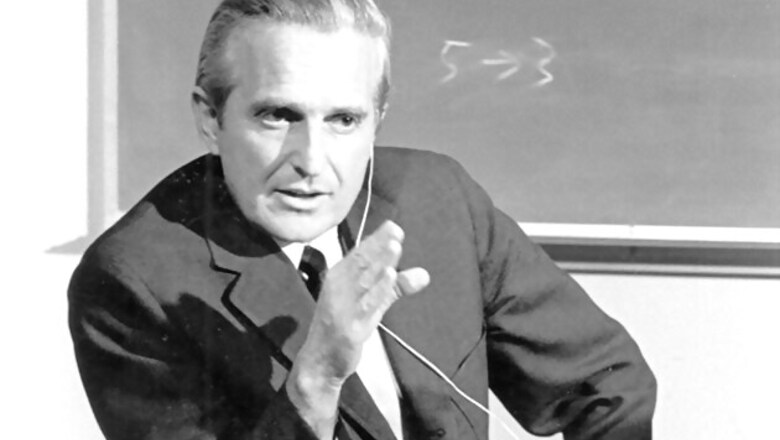
views
Palo Alto: Is the Internet a force for public good, or for social control? Or a bit of both? Such tensions, so prevalent in today's debates, were rife at the very dawn of the computer age.
Hoping to stimulate debate about the future of technology, a new production at Stanford University brings to stage the life of Internet pioneer Doug Engelbart who envisioned a more humanist role for computers.
The Demo, an experimental opera, dramatises the so-called Mother of All Demos in 1968 in which Engelhart's team at Stanford set up some 65 kilometers (40 miles) of cable to share a presentation with a conference on computers in San Francisco.
The 90-minute demonstration, which included Engelbart sharing a grocery list from his wife, lay the groundwork for the Internet, video conferencing and data cutting-and-pasting - and marked the invention of the computer mouse, a nomenclature for which the scientist is heard apologising.
At a time when computers were clunky number-crunching machines, Engelbart - who died in 2013 - opened a path for better known figures such as Apple's Steve Jobs and Microsoft's Bill Gates to develop the ever-expanding world of personal computers and gadgets.
"It grounds you in where we are now. We really tried to emulate the humanity that we saw in Engelbart," said Mikel Rouse, the co-composer of The Demo which premieres Wednesday evening.
"Without telling the audience what to think - because that's never interesting - the goal is that when they focus on Facebook or on privacy issues, they can think about what this is all about and where it came from," he said.
Rouse sits in a tie at a desk to portray Engelbart in The Demo, turning the complete 1968 experiment - jargon and all - into a libretto in which Rouse sings to a whirl of electronic music and projected images.
Fellow composer Ben Neill plays the mutantrumpet, an electronic-infused version of the trumpet he invented, in the role of Engelbart's assistant William English.
Contrast of cultures
The Demo flashes back to past episodes from Engelbart, who trained as a World War II navy radar technician.
After Japan's surrender, Engelbart spent a year in the Philippines. He was transformed at a Red Cross library in Leyte where he read an article in Life magazine about early US plans for computers.
The young Engelbart discovered the goal that later became his motto at Stanford - how to use machines to extend the power of the human mind.
Yet the influences around him were complicated. The Stanford Research Institute, with which he was affiliated, faced heated protests for working on military technology during the Vietnam War.
But even as the Pentagon encouraged early research on the Internet, the scientists took their inspiration instead from the 1960s California counter-culture.
Footage of the 1968 demo exists thanks to camera footage by Stewart Brand, who edited the hippie bible Whole Earth Catalog.
Engelbart himself dabbled in LSD, according to What the Dormouse Said, John Markoff's book on the era on which The Demo is inspired.
The opera offers hints of the era through sounds of protests and musical allusions to 1960s psychedelia and West Coast jazz.
But the heavy beats are more reminiscent of Electronic Dance Music, transplanting The Demo to the present day.
Asking questions through art
The Demo again comes back to 2015 through flashing images - of connectivity maps and tech companies - projected on the trusses of the concert hall.
Rouse's movements are projected overhead, and an entirely different set of characters resembling an office perform behind a transparent screen, in further representations of the Internet.
Experimentation in form is encouraged by the layout of Stanford's Bing Concert Hall, whose 842 seats are arranged as a "vineyard" surrounding the stage.
Built in 2013 with a design by leading acoustician Yasuhisa Toyota, the Bing Concert Hall marks a new thrust into the arts by Stanford - one of the world's best-endowed universities situated near headquarters of leading tech companies.
Wiley Hausam, executive director of Bing Concert Hall, said that Stanford hoped to offer a broader context through the arts.
The 1968 demo may at first glance appear to be an event unique to Silicon Valley, but a closer reading of Engelbart showed "a very deep humanistic impulse," Hausam said.
"We're at a critical moment in the history of technology and how it's manifested in our society, where we need to think very carefully about how we want to affect our daily lives and not merely invent things because they can be invented," he said.
####
















Comments
0 comment